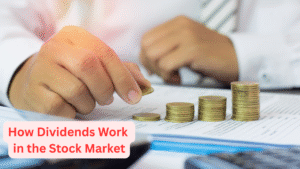 How Dividends Work in the Stock Market
How Dividends Work in the Stock Market
Dividends are one of the most attractive features of stock investing—especially for investors seeking regular income. But how do dividends work in the stock market? Who decides how much is paid? And are they a reliable source of return?
This guide will explain dividends in plain English: what they are, how they’re paid, and why they matter for your investment strategy.
What Is a Dividend?
A dividend is a portion of a company’s profits that it distributes to shareholders, typically in cash. Not all companies pay dividends, but many established businesses do as a way to reward investors.
Dividends are usually paid quarterly, though some companies offer monthly or annual payouts.
How Are Dividends Paid?
🧾 Example:
Let’s say you own 100 shares of a company that pays a quarterly dividend of $0.50 per share. Each quarter, you’d receive:
$0.50 × 100 = $50
You can choose to:
- Take the cash, which is deposited into your brokerage account
- Reinvest the dividend to buy more shares automatically (called a DRIP, or Dividend Reinvestment Plan)
Types of Dividends
1. Cash Dividends (most common)
Paid in cash directly to shareholders.
2. Stock Dividends
Paid in additional shares instead of cash.
3. Special Dividends
One-time payments issued when a company has excess profits (e.g., after a big asset sale).
4. Preferred Dividends
Fixed dividends paid to holders of preferred stock, often at higher rates.
Important Dividend Dates to Know
- Declaration Date
- The date the company announces the dividend.
- Ex-Dividend Date
- To receive the dividend, you must own the stock before this date.
- If you buy on or after this date, you won’t get the dividend.
- Record Date
- The company checks its records to confirm which shareholders are eligible.
- Payment Date
- The date the dividend is actually paid out.
Tip: Buy the stock before the ex-dividend date to receive the dividend.
Dividend Yield: What Does It Mean?
The dividend yield is a measure of how much a company pays in dividends relative to its stock price.
Formula:Dividend Yield = Annual Dividend ÷ Stock Price
🧮 Example:
If a stock trades at $100 and pays $4 per year in dividends, the yield is:
$4 ÷ $100 = 4%
High-yield stocks are appealing for income investors, but beware—too high a yield can be a red flag (e.g., signs of a struggling company).
Why Do Companies Pay Dividends?
- To attract long-term investors
- To share profits with shareholders
- To signal financial strength and stability
- To increase stockholder loyalty
Companies that pay consistent or growing dividends are often mature and profitable.
Which Companies Pay Dividends?
- Blue-chip stocks like Coca-Cola, Johnson & Johnson, and Procter & Gamble
- Utility companies, REITs, and consumer staples
- Dividend aristocrats—companies that have raised dividends for 25+ consecutive years
Younger, high-growth companies (like many in tech) often reinvest earnings instead of paying dividends.
Tax Considerations
- In the U.S., qualified dividends are taxed at a lower rate than ordinary income.
- Non-qualified dividends may be taxed at your regular income rate.
- Always check your tax bracket and consult a professional if unsure.
✅ FAQ: How Dividends Work in the Stock Market
1. Do all stocks pay dividends?
No. Many high-growth companies choose to reinvest profits into expansion instead of paying dividends.
2. Is a higher dividend yield always better?
Not always. Extremely high yields may indicate the company is in trouble or that the dividend is unsustainable.
3. Can companies stop paying dividends?
Yes. Companies can reduce or eliminate dividends if profits fall, especially during recessions or downturns.
4. How often are dividends paid?
Most U.S. companies pay quarterly, but some pay monthly or annually.
5. Are dividends guaranteed income?
No. Dividends are never guaranteed—they depend on the company’s performance and decisions by its board of directors.
